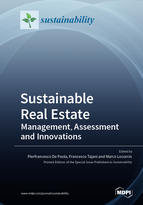Sustainable Real Estate: Management, Assessment and Innovations
A special issue of Sustainability (ISSN 2071-1050). This special issue belongs to the section "Sustainable Engineering and Science".
Deadline for manuscript submissions: closed (31 January 2021) | Viewed by 42219
Special Issue Editors
Interests: econometric models; mass appraisal; real estate market; risk management; urban and real estate economics; real estate investments; building management; economic valuation of real estate investment projects; environmental economics; transport economics; sustainability; knowledge management; corporate valuation
Special Issues, Collections and Topics in MDPI journals
Interests: property valuation; mass appraisal; urban economics; risk analysis; engineering economics; financial sustainability; decision support systems; sustainable urban development; life cycle assessment
Special Issues, Collections and Topics in MDPI journals
Interests: real estate market; risk management; urban and real estate economics; real estate investments; building management; economic valuation of real estate investment projects; environmental economics; real estate appraisal; property valuation; financial and economic analysis for investment projects; econometrics
Special Issues, Collections and Topics in MDPI journals
Special Issue Information
Dear Colleagues,
Production and consumption activities have determined a weakness of the sustainable real estate economy. The main problems are the subordination of public decision-making, which is subjected to pressure from big companies, inefficient appraisal procedures, excessive use of financial leverage in investment projects, the atypical nature of markets, income positions in urban transformations, and the financialization of real estate markets with widespread negative effects.
A delicate role in these complex problems is assigned to real estate appraisal activities, called to make value judgments on real estate goods and investment projects, the prices of which are often formed in atypical real estate markets, giving ever greater importance to sustainable development and transformation issues.
The Special Issue is dedicated, but not only limited, to developing and disseminating knowledge and innovations related to most recent real estate evaluation methodologies applied in the fields of architecture and civil, building, and environmental and territorial engineering. Suitable works include studies on econometric models, sustainable building management, building costs, risk management and real estate appraisal, mass appraisal methods applied to real estate properties, urban and land economics, transport economics, the application of economics and financial techniques to real estate markets, the economic valuation of real estate investment projects, the economic effects of building transformations or projects on the environment, and sustainable real estate.
Prof. Dr. Pierfrancesco De Paola
Prof. Eng. Francesco Tajani
Prof. Dr. Marco Locurcio
Guest Editors
Manuscript Submission Information
Manuscripts should be submitted online at www.mdpi.com by registering and logging in to this website. Once you are registered, click here to go to the submission form. Manuscripts can be submitted until the deadline. All submissions that pass pre-check are peer-reviewed. Accepted papers will be published continuously in the journal (as soon as accepted) and will be listed together on the special issue website. Research articles, review articles as well as short communications are invited. For planned papers, a title and short abstract (about 100 words) can be sent to the Editorial Office for announcement on this website.
Submitted manuscripts should not have been published previously, nor be under consideration for publication elsewhere (except conference proceedings papers). All manuscripts are thoroughly refereed through a single-blind peer-review process. A guide for authors and other relevant information for submission of manuscripts is available on the Instructions for Authors page. Sustainability is an international peer-reviewed open access semimonthly journal published by MDPI.
Please visit the Instructions for Authors page before submitting a manuscript. The Article Processing Charge (APC) for publication in this open access journal is 2400 CHF (Swiss Francs). Submitted papers should be well formatted and use good English. Authors may use MDPI's English editing service prior to publication or during author revisions.
Keywords
- Building management
- Building costs
- Mass appraisal methods
- Econometric models
- Real estate risk management
- Economic valuation of real estate investment projects
- Real estate market
- Social housing
- Urban economics
- Land
- Transport economics
- Real estate economics and finance
- Sustainable building transformations and economic effects on environment
- Green buildings








